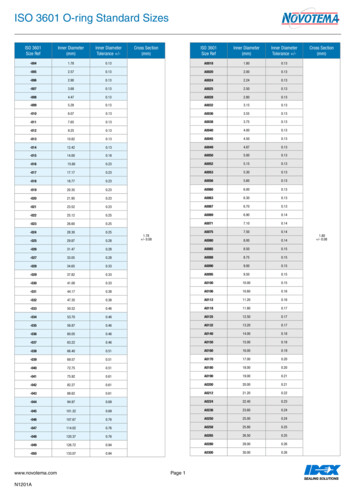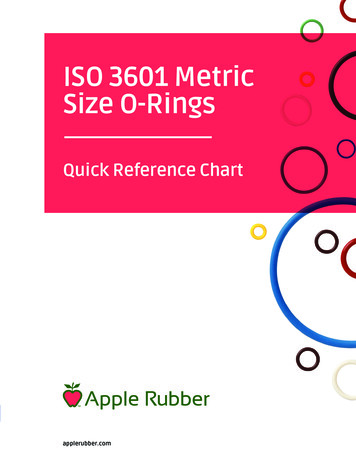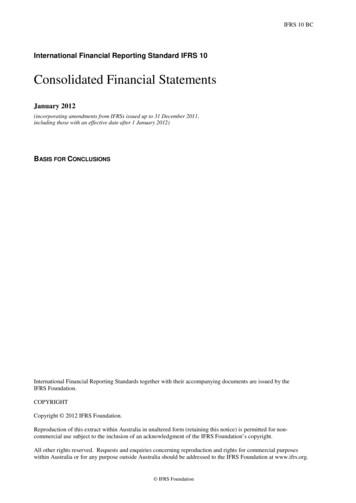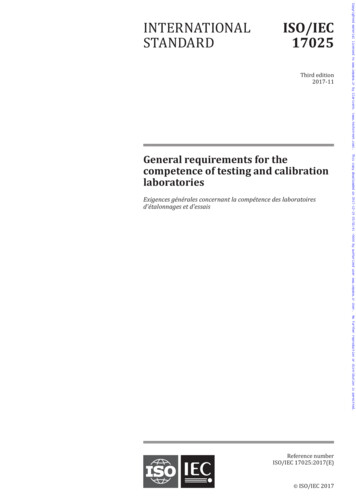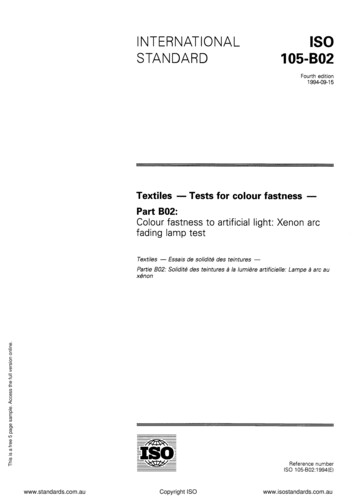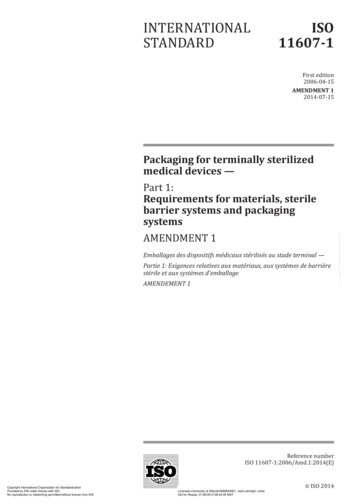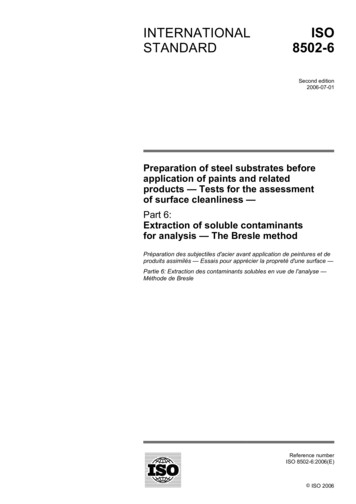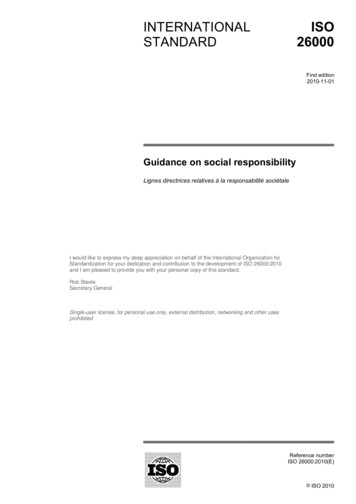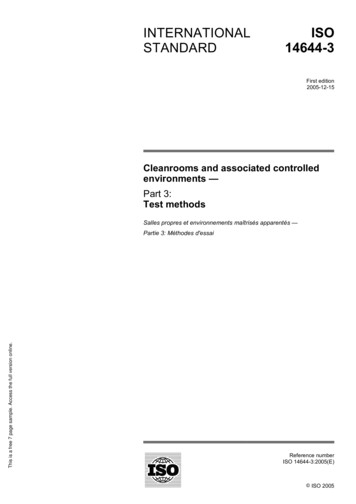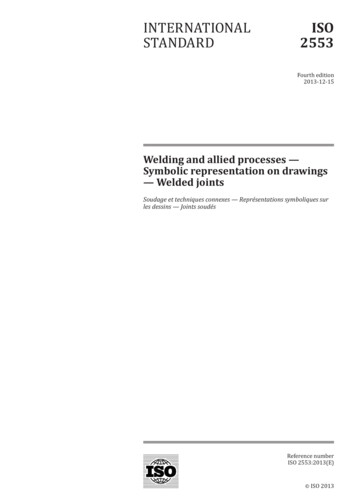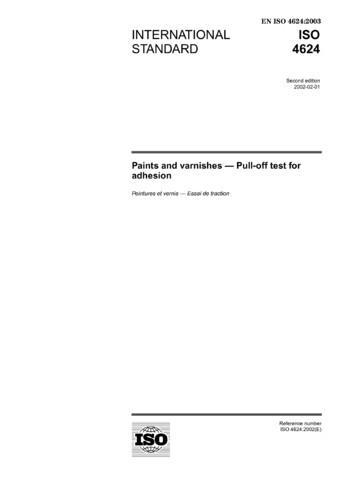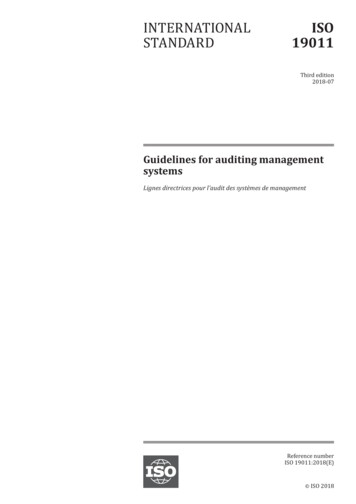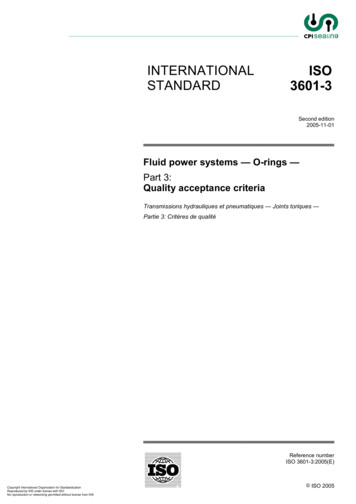
Transcription
INTERNATIONALSTANDARDISO3601-3Second edition2005-11-01Fluid power systems — O-rings —Part 3:Quality acceptance criteriaTransmissions hydrauliques et pneumatiques — Joints toriques —Partie 3: Critères de qualitéReference numberISO 3601-3:2005(E)Copyright International Organization for StandardizationReproduced by IHS under license with ISONo reproduction or networking permitted without license from IHS ISO 2005
ISO 3601-3:2005(E)PDF disclaimerThis PDF file may contain embedded typefaces. In accordance with Adobe's licensing policy, this file may be printed or viewed butshall not be edited unless the typefaces which are embedded are licensed to and installed on the computer performing the editing. Indownloading this file, parties accept therein the responsibility of not infringing Adobe's licensing policy. The ISO Central Secretariataccepts no liability in this area.Adobe is a trademark of Adobe Systems Incorporated.Details of the software products used to create this PDF file can be found in the General Info relative to the file; the PDF-creationparameters were optimized for printing. Every care has been taken to ensure that the file is suitable for use by ISO member bodies. Inthe unlikely event that a problem relating to it is found, please inform the Central Secretariat at the address given below. ISO 2005All rights reserved. Unless otherwise specified, no part of this publication may be reproduced or utilized in any form or by any means,electronic or mechanical, including photocopying and microfilm, without permission in writing from either ISO at the address below orISO's member body in the country of the requester.ISO copyright officeCase postale 56 CH-1211 Geneva 20Tel. 41 22 749 01 11Fax 41 22 749 09 47E-mail copyright@iso.orgWeb www.iso.orgPublished in Switzerland ISO 2005 – All rights reservedCopyright International Organization for StandardizationReproduced by IHS under license with ISONo reproduction or networking permitted without license from IHSii
ISO 3601-3:2005(E)ContentsPageForeword. ivIntroduction . iv1Scope . 12Normative references . 13Terms, definitions and symbols. 144.14.24.34.4Grades. 3Grade N (general purpose) . 3Grade S (special). 3Grade CS (critical service) . 3Selection of grade. 35Surface condition. 36Identification statement (reference to this part of ISO 3601). 4 ISO 2005 – All rights reservedCopyright International Organization for StandardizationReproduced by IHS under license with ISONo reproduction or networking permitted without license from IHSiii
ISO 3601-3:2005(E)ForewordISO (the International Organization for Standardization) is a worldwide federation of national standards bodies(ISO member bodies). The work of preparing International Standards is normally carried out through ISOtechnical committees. Each member body interested in a subject for which a technical committee has beenestablished has the right to be represented on that committee. International organizations, governmental andnon-governmental, in liaison with ISO, also take part in the work. ISO collaborates closely with theInternational Electrotechnical Commission (IEC) on all matters of electrotechnical standardization.International Standards are drafted in accordance with the rules given in the ISO/IEC Directives, Part 2.The main task of technical committees is to prepare International Standards. Draft International Standardsadopted by the technical committees are circulated to the member bodies for voting. Publication as anInternational Standard requires approval by at least 75 % of the member bodies casting a vote.Attention is drawn to the possibility that some of the elements of this document may be the subject of patentrights. ISO shall not be held responsible for identifying any or all such patent rights.ISO 3601-3 was prepared jointly by Technical Committee ISO/TC 20, Aircraft and space vehicles,Subcommittee SC 10, Aerospace fluid systems and components, and by Technical Committee ISO/TC 131,Fluid power systems, Subcommittee SC 7, Sealing devices.This second edition cancels and replaces the first edition (ISO 3601-3:1987), which has been technicallyrevised.ISO 3601 consists of the following parts, under the general title Fluid power systems — O-rings: Part 1: Inside diameters, cross-sections, tolerances and size identification code Part 3: Quality acceptance criteria Part 5: Suitability of elastomeric materials for industrial applicationsThe following parts are in preparation: Part 2: Housing dimensions for general applications Part 4: Anti-extrusion devices (back-up rings)IntroductionIn fluid power systems, power is transmitted and controlled through a fluid (liquid or gas) under pressure withinan enclosed circuit. Components must be designed to meet these requirements under varying conditions.Testing of components to meet performance requirement provides users a basis of assurance for determiningdesign application and for checking component compliance with their stated requirements. ISO 2005 – All rights reservedCopyright International Organization for StandardizationReproduced by IHS under license with ISONo reproduction or networking permitted without license from IHSiv
INTERNATIONAL STANDARDISO 3601-3:2005(E)Fluid power systems — O-rings —Part 3:Quality acceptance criteria1ScopeThis part of ISO 3601 lays down the quality acceptance criteria of O-rings used in fluid systems, thedimensions of which are standardized in ISO 3601-1, ISO 16031-1 and ISO 16031-2.This part of ISO 3601 also defines and classifies surface imperfections on O-rings and specifies maximumacceptable limits for these imperfections.This part of ISO 3601 is also applicable to O-rings to be used in aerospace construction.2Normative referencesThe following referenced documents are indispensable for the application of this document. For datedreferences, only the edition cited applies. For undated references, the latest edition of the referenceddocument (including any amendments) applies.ISO 3601-1, Fluid power systems — O-rings — Part 1: Inside diameters, cross-sections, tolerances and sizeidentification codeISO 5598, Fluid power systems and components — VocabularyISO 16031-1, Aerospace fluid systems — O-rings, inch series: Inside diameters and cross sections,tolerances and size-identification codes — Part 1: Close tolerances for hydraulic systemsISO 16031-2, Aerospace fluid systems — O-rings, inch series: Inside diameters and cross sections,tolerances and size-identification codes — Part 2: Standard tolerances for non-hydraulic systems3Terms, definitions and symbolsFor the purposes of this document, the terms and definitions given in ISO 5598 and the following apply.3.1backrindlongitudinal imperfection in which the rubber adjacent to the flash line shrinks below the level of the mouldingand has a “U”-like or “W”-like cross section with the flash frequently being ragged or torn[see Figure 1]3.2combined flashcombination of offset, flash and parting line projection ISO 2005 – All rights reservedCopyright International Organization for StandardizationReproduced by IHS under license with ISONo reproduction or networking permitted without license from IHS1
ISO 3601-3:2005(E)3.3inside diameterd1O-ring inside diameter3.4cross-section diameterd2O-ring cross-section diameter3.5excessive trimmingflattened and often roughened area around the inner and/or outer diameters of an O-ring caused by thetrimming process[see Figures 2a and 2b]3.6flashfilm-like material that extends from the parting line projection or inner and/or outer diameters, caused bymould separation or present due to inadequate trimming[see Figure 3]3.7flow markthread-like recess, usually curved, of very slight depth in the unflexed state, with normal surface texture andround edge, caused by incomplete flow and knit of the material[see Figure 4]3.8foreign materialany extraneous matter embedded in the surface of the O-ring, e.g. contamination, dirt, etc.3.9indentationdepression, usually irregular in form, caused by the removal of inclusions from the surface or the build-up ofhardened deposits on the surface of the mould cavity[see Figure 5]3.10mismatchcross-sectional radius in one ring half being unequal to that of the other half, caused by dimensional differencein mould halves3.11non-fillrandomly spaced, irregularly shaped surface indentation having a coarser texture than the normal O-ringsurface, caused by incomplete filling of, and or the trapping of air in, the mould cavity[see Figure 6]3.12off-registermisalignment of O-ring halves, caused by the lateral shift of one mould cavity plate relative to other ISO 2005 – All rights reservedCopyright International Organization for StandardizationReproduced by IHS under license with ISONo reproduction or networking permitted without license from IHS2
ISO 3601-3:2005(E)3.13offsetmismatch and/or off-register of O-ring halves[see Figure 7]3.14parting-line indentationshallow saucer-like recess sometimes triangular in shape, located on the parting line at the inner and/or outerdiameters, caused by deformation of the mould edge at the parting line3.15parting-line projectioncontinuous ridge of material situated at the parting line of inner and/or outer diameters caused by worn orexcessively rounded edges of the mould cavity44.1GradesGrade N (general purpose)Grade N (general purpose) identifies acceptance criteria for O-rings intended for general use. See Table 1.4.2Grade S (special)Grade S (special) identifies acceptance criteria for O-rings intended for applications requiring a higher level ofquality and/or precision with respect to dimensional tolerances of surface imperfections. For example,aerospace or critical industrial or automotive applications are covered by this grade. See Table 2.4.3Grade CS (critical service)This grade identifies acceptance criteria for O-rings intended for applications requiring a much higher level ofquality and/or precision with respect to dimensional tolerances of surface imperfections. For example, criticalservice aerospace or medical applications, where the surface of the O-ring must be near-perfect to perform ina satisfactory manner, are covered by this grade. See Table 3.4.4Selection of gradeIf the user does not specify the grade at the time of purchase, Grade N will be assumed to be the qualityrequirement, except for specific aerospace applications where Grade S will be assumed to be the qualityrequirement.5Surface condition5.1 The O-ring surfaces shall be free from cracks, ruptures, blisters or other imperfections that are greaterthan the limits given in Tables 1, 2 and 3 when the unstretched ring is viewed under a 2 magnifier viewer withadequate illumination. Other methods should be agreed between the manufacturer and the user.5.25.1.There shall be no foreign material embedded in the surface visible under the viewing conditions given in ISO 2005 – All rights reservedCopyright International Organization for StandardizationReproduced by IHS under license with ISONo reproduction or networking permitted without license from IHS3
ISO 3601-3:2005(E)5.3Flow marks, non-fills and indentations within the limits of Tables 1, 2 and 3 shall not be allowed ifa)there are more than three in any 25 mm length of circumference for Grades N and S or there is more thanone in any 25 mm length of circumference for Grade CS;b)they interconnect;c)there are more than three that are separated from each other by a distance that is less than the maximumlimiting dimensions of such imperfection for Grades N and S, or there are more than two that areseparated from each other by a distance that is less than the maximum limiting dimensions of suchimperfection and only one per 25 mm length of circumference for Grade CS.5.4There shall be no flow marks that are essentially radially orientated.5.5The surface resulting from any excessive trimming shall be smoothly blended.5.6Wire gauges of the appropriate size may be used to determine the size of the defect by comparison.5.7 In case of dispute, the methods of measurement shall be agreed upon between the manufacturer andthe customer.6Identification statement (reference to this part of ISO 3601)Use the following statement in test reports, catalogues and sales literature when electing to comply with thispart of ISO 3601:“Surface imperfection limits are in accordance with ISO 3601-3:2005, Fluid power systems — O-rings —Part 3: Quality acceptance criteria.” ISO 2005 – All rights reservedCopyri
1 Scope This part of ISO 3601 lays down the quality acceptance criteria of O-rings used in fluid systems, the dimensions of which are standardized in ISO 3601-1, ISO 16031-1 and ISO 16031-2. This part of ISO 3601 also defines and classifies surface imperfections on O-rings and specifies maximum acceptable limits for these imperfections. This part of ISO 3601 is also applicable to O-rings to be used in File Size: 1MBPage Count: 15
